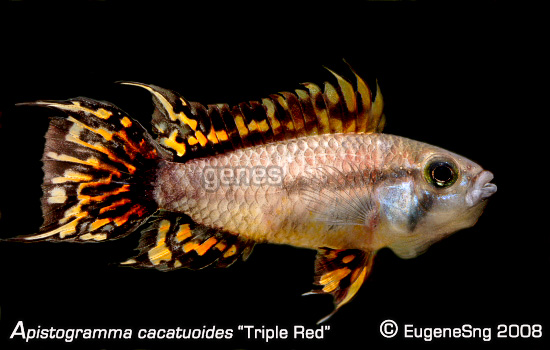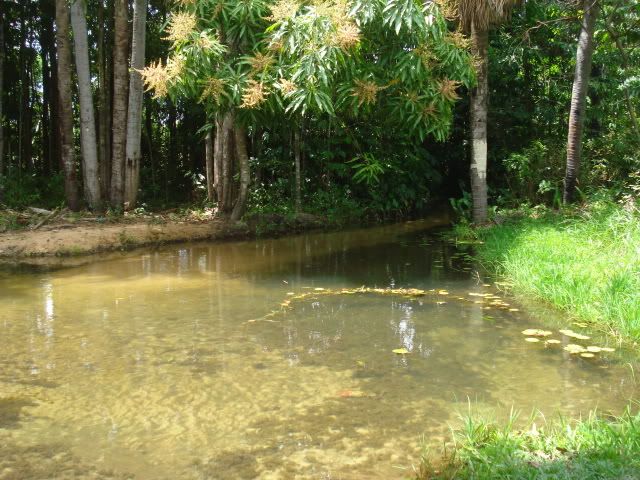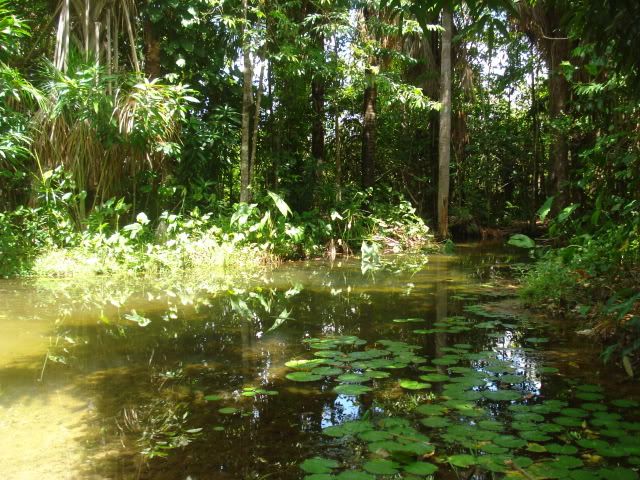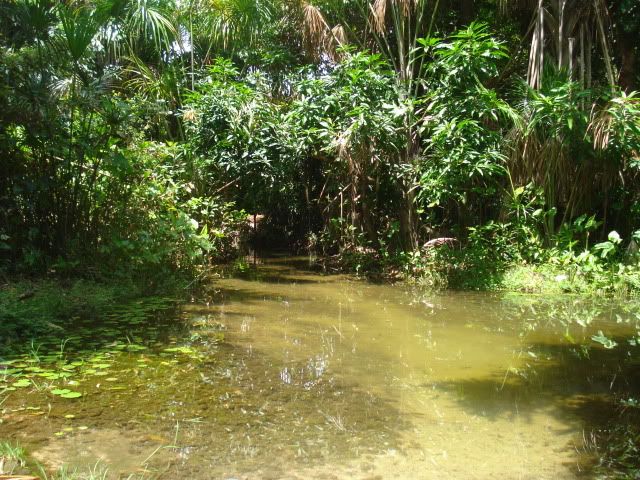1) Caudal (tail) fin is lyrate in mature specimens.
2) Dorsal (top) fin of males have long membranes, typically from the
2nd to 8th spines.
3) Size is bigger then female

FEMALE:
1) Caudal fin is round or just slightly truncate
2) Dorsal fin tips are short
3) When ready/during breeding, female is yellow in colour.
4) Ventral fin is black especially during breeding.
5) Size is smaller then males.

*source : aquaticquotient
this habitat






Name:
Apistogramma cacatuoides - Cockatoo Apisto
Color Variations:
Orange Flash, Super Red, Double Red, Half-Orange, Common
Single Red, Triple Red, Orange, Yellow, Gold, Gold Triple Red.
Family:
Cichlidae.
Subfamily:
Geophaginae
Distribution:
The natural range of this species covers parts of the western Amazon basin, around the area where the borders of Colombia, Peru and Brazil meet. It occurs in the drainages of several rivers, including the Ucayali, Solimôes, Japura, Napo and the Amazon itself. Most of the fish seen on sale in the trade these days originate from commercial breeding facilities in the Far East or Eastern Europe.
Habitat:
Inhabits slow-moving streams, creeks and tributaries, as well as smaller rivers and floodplain lakes.
Maximum Standard Length:
A good-sized male can reach around 3.6" (9cm). Females are much smaller, growing to only 2.8" (6.5cm).
Minimum Tank Size:
18" x 15" x 12" (45cm x 37.5cm x 30cm) - 53 litres.
Tank Setup:
Replicate their natural habitat with lots of bogwood, driftwood and mopani wood. They also love having littered leaves at the bottom of the tank (this is where females will hide from males and predators in the wild, and often where females will lay their eggs). However, Cacatuoides will also do very well in a planted tank setup. Most Apistogrammas do not like bright lighting.
Temperature:
75 to 82°f (24 to 28°c)
pH Range:
Prefer acidic (6 to 6.5) but can tolerate slightly alkaline waters (7 to 7.4)
Hardness:
Again, prefer softer water, but can be kept (and bred!) in harder waters - 4 to 6°dH is recommended but upto 10°dH will suffice.
Diet:
Wild caught cacatuoides can be very picky with their food - some will not touch dry foods at all. If you find this is the case, feed a variety of frozen foods including Daphnia. As most cacatuoides on sale in Britain are tank-bred though, they will eat nearly anything including flake. Feed a balanced diet including frozen foods (preferably with the addition of live foods also) and some herbivore dry food (vegetable/spirulina).
Compatibility:
Male cacatuoides can be aggressive towards other males, so it isn't recommended to keep more than one male in a tank less than 48" long as they tend to form territories up to 24" in length. Males can also have problems with other males from the Apistogramma genus so same applies there. Males can even be aggressive towards females (especially in a trio around breeding time), so make sure adequate cover is provided for the females.
Sexual Dimorphism:
Males are much larger with more vivid colouration.
Breeding:
Apistogramma cacatuoides are relatively simple to breed. Provide an adequately sized tank with plenty of cover, add a single male and any amount of females, feed with a variety of frozen food and a good quality staple dry food and you should have no problems.
Notes:
Apistogramma cacatuoides are probably the most commonly available dwarf cichlid in the United Kingdom. They are widely tank bred (the majority of the specimens for sale in the United Kingdom will be tank bred), and because of this are fairly adaptable to water conditions.
cacatuoides come in a few colour variations, including Sunset (yellow, blending to red finnage), Double & Triple Red (Deep red tails with black web patterning). True females of these variations will have similar finnage, though on a smaller scale with less colour.
As previously mentioned, Apistogramma cacatuoides will tolerate and even breed in harder water. This is ideal for areas in which tap water is found to be slightly more alkaline and slightly harder than usual - no water softening devices are required. They will however, prefer softer water conditions.
*source: seriouslyfish, aquaticquotient



No comments:
Post a Comment